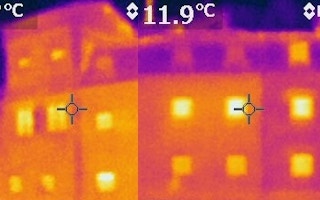Preserving some of Britain’s most historic buildings, conserving its energy supplies and reducing climate change are the triple-win result of a new alliance formed originally to save money.
You might think that a charity that looks after stately homes, a brewery company, and a harbour traffic management group in the Scottish port of Oban have little in common.
However, they have a significant link: all are installing heat pumps that use seawater, to cut fossil fuel use and keep the heating bills down, helping the planet to avoid overheating.
Energy use
The organisations are members of the growing Fit for the Future Network, a UK-based group of 500 people from 81 organisations who share ideas on the best ways to cut energy use and save money at the same time.
The unlikely alliance includes the National Trust, the charity responsible for the care of historic houses and countryside across England, Wales and Northern Ireland (a separate body does the work in Scotland), and several partners.
The partnership with Adnams Brewery in the Suffolk town of Southwold in eastern England, began with a thermal-imaging camera. It was being used by the National Trust in Wales to detect areas that required insulation and sealing in their mansions and holiday cottages, saving the charity large sums of money.
Keith Jones, a Trust environment adviser, says the camera is also a useful way of showing people how their actions affect heat loss from buildings.It is a strong educational tool, as people cannot see energy, and so often it is dismissed out of hand as someone else’s problem. One of the strongest images I have used is of a back door left open at Plas Newydd country house, after full insulation.
“The back door had been wedged open, which highlighted a lack of ownership of the energy use on site. The thermal image of the heat loss brought this home to all.
“Seeing the heat come off a phone charger plugged into a wall socket that was not connected to a phone, or the heat loss from a conference phone not being used, really brings home the idea of waste.”
“
We are currently writing the business case for recovering heat from process waste in our distillery in order to provide heat within our brewery from the brewing liquor.
Benedict Orchard, sustainability manager, Adnams
At a meeting of Fit for the Future Network, Benedict Orchard, sustainability manager for Adnams, mentioned that he was considering buying such a camera but was unsure whether the expense was justified. The cameras cost anything between £500 and £15,000, depending on quality (US$645-19,350).
The Trust volunteered to lend him its camera, and he used it to measure the amount of heat lost at six of its old pubs and 13 brewery shops. The findings led to the implementation of an insulation programme that will save the brewery a significant amount of money while saving the planet from carbon emissions.
Through the Trust, Orchard learned about heat pumps and a subsequent visit was made by brewery staff to Plas Newydd, where the Trust has installed a marine source heat pump. It works by drawing warmth from seawater through a compressor to heat the former stately home of the Marquis of Anglesey, to keep the thousands of visitors comfortable and supply hot water. The pump is like a refrigerator operating to produce cold air, but in reverse.
The system uses far less energy to heat the same amount of space as a gas-condensing boiler. There is in any case no gas supply near Plas Newydd, so the old heating system relied on expensive oil. The pump is saving the Trust 128,000 litres of oil and £50,000 ($64,500) a year.
However, the performance of heat pumps can vary, depending on how and where they are installed, so talking to people who have had experience of getting them working properly is important.
Jones built the Trust’s heat pump after seeing one installed at another massive stately home, Castle Howard in Yorkshire in the north of England.
He also looked at the one in Portsmouth Dockyard, a historic naval site, and consulted the Royal National Lifeboat Institution,which has a century of experience of working with seawater, to find out which metal to use to avoid corrosion. The Trust was advised to use plastic, which does not corrode.
Jones says: “The Plas Newydd pump is working brilliantly three years in. We are now sharing our lessons, for example with Oban harbour, on what we could have done better.”
New ideas
Orchard says he learned a lot from his visit to Anglesey to see the Plas Newydd pump. “It helped us to understand a renewable heating technology that we had not previously explored. We went with the intention of finding out whether we could apply the same thinking back at home in Southwold (with North Sea water), and instead came home with ideas around electric vehicles and process heat recovery.
“We are currently writing the business case for recovering heat from process waste in our distillery in order to provide heat within our brewery from the brewing liquor.
“Thanks to the visit, we have been able to identify not only potential sources of heat [within our own plant] but also where we could use the heat. It is an exciting project with great business benefits, which we hope to implement shortly.
“We now also understand more about electric vehicles, and have installed charging points at all our managed inns.”
This story was published with permission from Climate News Network.










